News
The 探花合集 Weekly for July 8th, 2025

This Week in the 探花合集 Weekly
Guest Editorial: Federal Policymakers Should Read the Drug Policy Research They've Funded
By Barbara “Basia” Andraka-Christou, JD, PhD
The federal government recently reported a stunning in drug overdose deaths. It’s a positive omen, but it risks lulling policymakers into a false sense of accomplishment when more work must be done. Let’s not forget that overdose deaths are still unacceptably high, with tens of thousands of Americans dying each year and millions more needing evidence-based treatments. While we need further federal action to solve this crisis, not just any demand- or supply-side policies will work—they must be smart policies, informed by evidence.
Fortunately, federal policymakers need not fly blindly. The federal government has already funded millions of dollars in high-quality research to study the effects of different policies related to addiction and overdose. Unfortunately, policymakers sometimes ignore the very studies they funded. Imagine any private sector, multitrillion dollar company paying some of the best analysts to study the effects of corporate policies but then failing to read the findings. Indeed, it is wasteful for the government to ignore observations from the very studies it has funded. Below are key findings of several publicly funded studies that must be considered as the current administration and Congress seek to decrease overdose deaths.
Nicholas Athanasiou, MD, MBA, DFASAM
Editor in Chief
with Co-Editors: Brandon Aden, MD, MPH, FASAM; John A. Fromson, MD; Jack Woodside, MD
Lead Story
Journal of General Internal Medicine
This study used interrupted-time-series analysis to model prescriber-level trends in buprenorphine prescriptions after recent federal policy changes. Researchers found that the elimination of the waiver requirement to prescribe buprenorphine in December 2022 was associated with a significant increase in the number of buprenorphine prescribers but a decrease in the mean number of patients and the mean number of prescriptions per prescriber. Changes in telehealth flexibilities and relaxed training requirements were largely not associated with prescribing changes. This study expands on prior research by providing further insight as to why waiver elimination has not increased the number of patients receiving buprenorphine, as expected.
Research and Science
Journal of Substance Use and Addiction Treatment
This study compared the odds of discontinuing treatment for patients receiving buprenorphine via 3 modes of care—telehealth, in-person, or hybrid (telehealth initiation then combination of both)—during early phase (first 3 months) or late phase (4-12 months). Claims data were used from 10,783 commercially insured patients. During the early treatment phase, telehealth had significantly lower odds of treatment discontinuation compared to the other modes (OR=0.83). During the late treatment phase, hybrid care had significantly lower odds of treatment discontinuation compared to the other modes (OR=0.73). Stimulant users had higher odds of discontinuation for both early (OR=1.31) and late (OR=1.29) phases. The authors suggest treatment initiation via telehealth and continued with a hybrid model will improve retention.
馃敁
BMJ Open
This study compared outcomes for OUD treatment with methadone maintenance therapy (MMT) vs buprenorphine-naloxone (bup/nal) using data collected between 2018 and 2023 for another study. There were 2,601 participants, of whom 2,068 received MMT and 533 received bup/nal. Non-responders (>50% of drug screens positive for opioids) were more common with MMT (12%) than bup/nx (8%, p=0.025). However, there was no statistically significant difference in ongoing opioid use between the two treatment modalities. Those on MMT were more likely to remain in treatment at 12 months (OR=1.8, p<0.001). Retention in treatment at 12 months was also more likely for women (OR=1.4) and those currently working (OR=1.4) and less likely for those with intravenous drug use (OR=0.5).
馃敁
Translational Psychiatry
Drug development for alcohol use disorders (AUD) is stalled as promising compounds fail in clinical trials. This study used genetically diverse rats to model human variability and test Memantine, which failed clinical trials, and Naltrexone, an approved AUD medication. Rats were screened for drinking behavior, motivation, and relapse. Memantine reduced both alcohol and saccharin intake in all rats, lacking selectivity. Naltrexone reduced alcohol use only in responders, mostly males. Responders and non-responders drank similarly, but only responders showed cue-induced relapse. These findings mirror clinical results and show that accounting for individual and sex differences in preclinical models may better predict drug efficacy in AUD.
Learn More
馃敁&苍产蝉辫;
Alcohol, Clinical and Experimental Research
Solitary alcohol drinking is associated with increased risk of alcohol use disorder (AUD) and other poor outcomes. Using the Monitoring the Future panel study from 1977 to 2022, researchers assessed trends in solitary drinking in young adults (19-30 years old). Overall, 40% of young adults reported at least one episode of solitary drinking in the previous year. Over the study period, rates of solitary drinking initially decreased, but then steadily increased over the last couple of decades. Rates of solitary drinking increased more among females than males, such that in recent years rates are similar between males and females.
Journal of Addiction Medicine
While developing the Clinical Practice Guideline on the Management of Stimulant Use Disorder (StUD), several gaps in knowledge were identified. In this commentary, the authors review these gaps and identify areas in need of future research, including: the development of novel pharmacotherapies for StUD treatment, potential use of currently approved medications, neuromodulation techniques, and research around contingency management including addressing barriers to its implementation. Research is also needed around the treatment of stimulant intoxication, withdrawal, and secondary and tertiary prevention such as harm reduction, and addressing specific populations, including adolescents, pregnant individuals, and incarcerated individuals.
In the News
The New York Times
Boston Herald
馃敁
Food & Wine
馃敁
Milwaukee Journal Sentinel
馃敁
WBUR
馃敁
Spotlight PA
